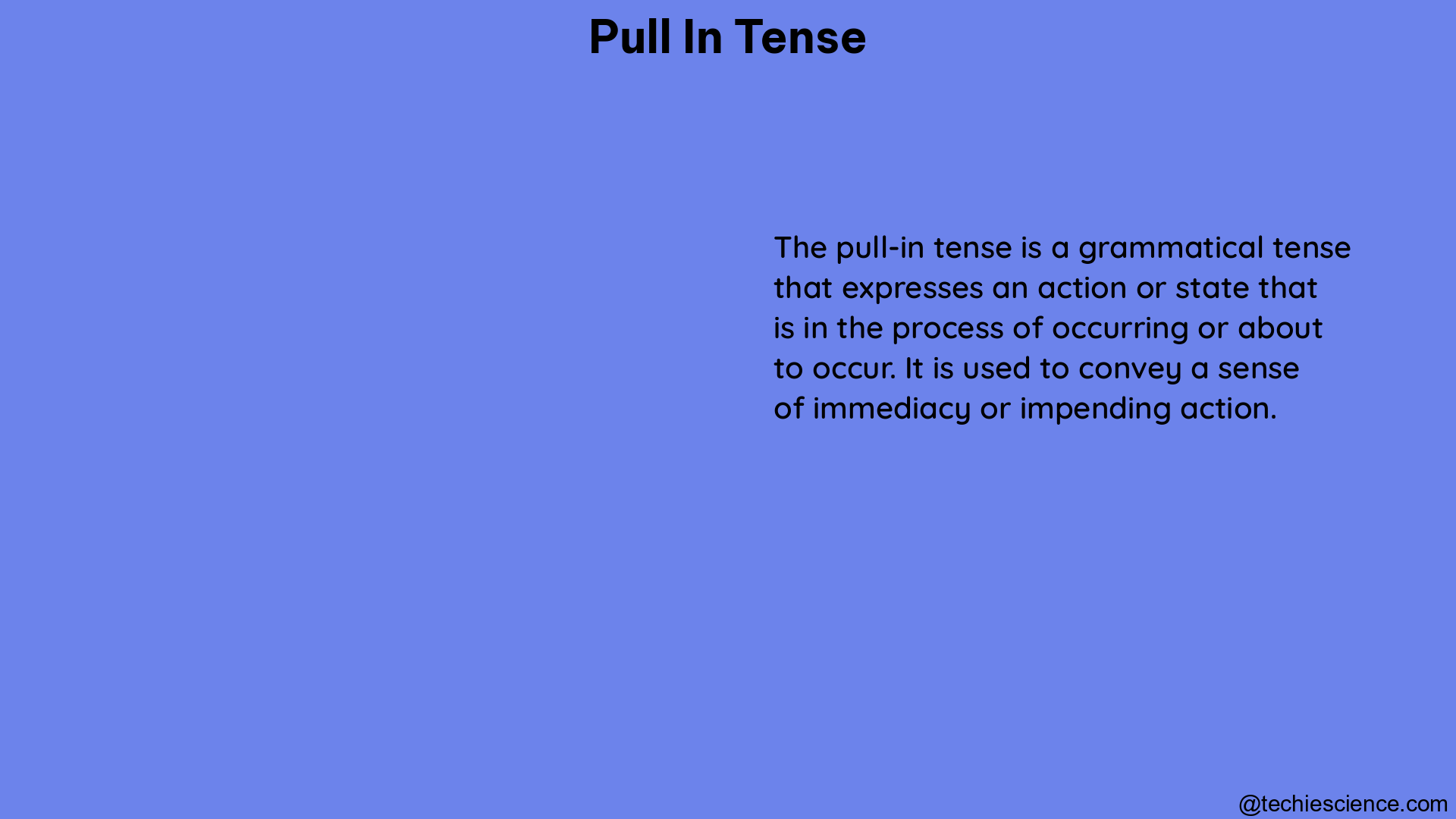The verb “pull” in English grammar follows a regular conjugation pattern, with various tenses and forms that are essential for effective communication. This comprehensive guide delves into the intricacies of the pull in tense, providing a detailed exploration of its usage, examples, and practical applications.
Present Tense
Simple Present
In the simple present tense, the verb “pull” takes the following forms:
– I pull
– You pull
– He/She/It pulls
– We pull
– You pull
– They pull
Example: She pulls the door open every morning to let the cat out.
Present Progressive
The present progressive tense of “pull” is formed using the present tense of the verb “to be” and the present participle of “pull”:
– I am pulling
– You are pulling
– He/She/It is pulling
– We are pulling
– You are pulling
– They are pulling
Example: The children are pulling the wagon up the hill.
Past Tense

Simple Past
The simple past tense of “pull” is formed by adding the suffix “-ed” to the verb:
– I pulled
– You pulled
– He/She/It pulled
– We pulled
– You pulled
– They pulled
Example: He pulled the rope tightly to secure the boat to the dock.
Past Progressive
The past progressive tense of “pull” is formed using the past tense of the verb “to be” and the present participle of “pull”:
– I was pulling
– You were pulling
– He/She/It was pulling
– We were pulling
– You were pulling
– They were pulling
Example: The workers were pulling the heavy machinery onto the truck.
Past Participle
Simple Past Participle
The simple past participle of “pull” is formed by adding the suffix “-ed” to the verb:
– I have pulled
– You have pulled
– He/She/It has pulled
– We have pulled
– You have pulled
– They have pulled
Example: The car was pulled to the side of the road by the tow truck.
Past Participle Progressive
The past participle progressive tense of “pull” is formed using the present perfect tense of the verb “to be” and the present participle of “pull”:
– I have been pulling
– You have been pulling
– He/She/It has been pulling
– We have been pulling
– You have been pulling
– They have been pulling
Example: The team has been pulling together to complete the project on time.
Future Tense
Simple Future
The simple future tense of “pull” is formed using the auxiliary verb “will” and the base form of the verb:
– I will pull
– You will pull
– He/She/It will pull
– We will pull
– You will pull
– They will pull
Example: The train will pull out of the station at 6 PM sharp.
Future Progressive
The future progressive tense of “pull” is formed using the auxiliary verb “will” and the present participle of the verb:
– I will be pulling
– You will be pulling
– He/She/It will be pulling
– We will be pulling
– You will be pulling
– They will be pulling
Example: The team will be pulling together to finish the project by the deadline.
Conditional Tense
Simple Conditional
The simple conditional tense of “pull” is formed using the auxiliary verb “would” and the base form of the verb:
– I would pull
– You would pull
– He/She/It would pull
– We would pull
– You would pull
– They would pull
Example: If the situation required it, I would pull the emergency brake.
Conditional Progressive
The conditional progressive tense of “pull” is formed using the auxiliary verb “would” and the present participle of the verb:
– I would be pulling
– You would be pulling
– He/She/It would be pulling
– We would be pulling
– You would be pulling
– They would be pulling
Example: If the weather permitted, the workers would be pulling the heavy equipment into the warehouse.
Imperative
The imperative form of “pull” is used to give commands or instructions:
– Pull
– Let’s pull
Example: Pull the door closed behind you.
Additional Considerations
It’s important to note that the verb “pull” can also be used in various phrasal verb constructions, such as “pull away,” “pull down,” “pull off,” and “pull up,” each with its own unique meaning and usage. Additionally, the verb “pull” can be used in passive voice constructions, where the subject receives the action of the verb, rather than performing it.
Conclusion
The pull in tense is a crucial aspect of English grammar, and understanding its various forms and applications is essential for effective communication. This comprehensive guide has provided a detailed exploration of the present, past, past participle, future, and conditional tenses of the verb “pull,” as well as its imperative form, offering a valuable resource for English language learners and enthusiasts alike.
References:
- Simple English Wiktionary – Pulled. (n.d.). Retrieved from https://simple.wiktionary.org/wiki/pulled
- WordReference.com – Conjugation of pull. (n.d.). Retrieved from https://www.wordreference.com/conj/enverbs.aspx?v=pull
- Gymglish – English Verb Conjugation – To pull. (n.d.). Retrieved from https://www.gymglish.com/en/conjugation/english/verb/to_pull
Hi… I am Sowndharya Jagadeeswaran, a university rank holder in M.A. English Literature. I have also done my master’s in Business Administration. Inquisitive as I am, my interest in action-oriented research helped me publish research papers in reputed journals. Now, as a career, I am an instructor where I teach young and adorable students the intricate technicalities of Public Speaking and Creative Writing. I also enjoy writing articles on topics I specialize and research in.
You can connect with me through LinkedIn.-